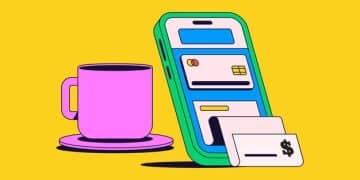Digital Payment Solutions for the Unbanked in the US: Closing the Gap

Digital payment solutions are crucial for financial inclusion in the U.S., providing the unbanked with access to essential financial services, fostering economic empowerment, and reducing reliance on cash transactions, ultimately bridging the financial inclusion gap.
The United States, a global economic powerhouse, paradoxically faces a significant challenge: a substantial portion of its population remains unbanked or underbanked. Digital payment solutions for the unbanked in the US: bridging the financial inclusion gap are becoming increasingly vital in addressing this issue, offering avenues for financial empowerment and inclusion.
Understanding the Unbanked Population in the US
To effectively address the challenge of financial exclusion, it’s crucial to grasp the complexities of the unbanked population within the United States. This involves identifying who they are, where they are located, and the primary reasons behind their lack of access to traditional banking services.
Defining the Unbanked and Underbanked
The unbanked are individuals who do not have a bank account at a traditional financial institution. The underbanked, on the other hand, have a bank account but still rely on alternative financial services, such as payday loans, money orders, and check-cashing services, which often come with high fees and unfavorable terms.
Demographics and Geographic Distribution
The unbanked population is not evenly distributed across the United States. Certain demographic groups and geographic regions are disproportionately affected. Understanding these patterns is crucial for tailoring solutions to specific needs.
- Low-Income Households: Individuals and families with low incomes are more likely to be unbanked due to factors such as high fees, minimum balance requirements, and a lack of trust in financial institutions.
- Minority Groups: Racial and ethnic minorities, including African Americans and Hispanics, are overrepresented among the unbanked, often due to historical and systemic barriers to financial access.
- Rural Communities: Residents of rural areas may have limited access to bank branches, making it difficult to open and maintain accounts.
- Young Adults: Younger individuals may be less likely to have bank accounts due to a lack of financial literacy or a preference for alternative payment methods.

The unbanked population in the U.S. comprises a diverse group of individuals with unique circumstances and needs. By understanding their demographics and geographic distribution, we can better address the barriers they face in accessing traditional banking services.
The Role of Digital Payment Solutions
Digital payment solutions are transforming the financial landscape, particularly for the unbanked. These technologies offer innovative ways to manage money, make transactions, and access financial services, often without the need for a traditional bank account.
Mobile Banking and Digital Wallets
Mobile banking apps and digital wallets are among the most popular digital payment solutions. They enable users to perform a variety of financial tasks directly from their smartphones, including:
- Account Management: Check balances, view transaction history, and transfer funds.
- Bill Payments: Pay bills securely and conveniently.
- Peer-to-Peer Transfers: Send and receive money from friends and family.
- Online Shopping: Make purchases online without a credit card.
Prepaid Cards
Prepaid cards are another valuable option for the unbanked. These cards can be loaded with funds and used for purchases, bill payments, and ATM withdrawals. They offer several advantages:
- No Credit Check: Prepaid cards do not require a credit check, making them accessible to individuals with limited or no credit history.
- Budgeting Tool: Users can load a specific amount onto the card, helping them manage their spending and avoid overdrawing.
- Online Safety: Prepaid cards can be used for online purchases without exposing a bank account or credit card.
Digital payment solutions are empowering the unbanked by providing them with convenient, affordable, and accessible financial tools. These technologies are helping to bridge the financial inclusion gap and improve the financial well-being of underserved communities.
Benefits of Increased Financial Inclusion
Expanding financial inclusion offers significant benefits for individuals, communities, and the economy as a whole. When more people have access to financial services, they can participate more fully in economic activities and improve their overall quality of life.
Economic Empowerment
Financial inclusion empowers individuals by giving them the tools and resources they need to build assets, manage their finances, and achieve their financial goals. This includes:
- Savings: Access to savings accounts allows individuals to set aside money for emergencies, education, or retirement.
- Credit: Access to credit enables individuals to finance major purchases, start businesses, and invest in their future.
- Financial Literacy: Financial education programs help individuals understand how to manage their money, make informed financial decisions, and avoid predatory lending practices.
Community Development
Increased financial inclusion also benefits communities by stimulating economic growth, reducing poverty, and improving social outcomes. This includes:
- Small Business Growth: Access to capital and financial services enables entrepreneurs to start and grow businesses, creating jobs and boosting local economies.
- Job Creation: As more people gain access to financial services, they can participate more fully in the workforce, leading to increased employment rates and economic productivity.
- Reduced Crime: Studies have shown that increased financial inclusion can reduce crime rates by providing individuals with legitimate economic opportunities.

The benefits of increased financial inclusion are far-reaching, impacting individuals, communities, and the economy. By working to expand access to financial services, we can create a more equitable and prosperous society for all.
Challenges and Barriers to Adoption
Despite the potential benefits of digital payment solutions, several challenges and barriers hinder their widespread adoption among the unbanked. Addressing these obstacles is crucial for maximizing the impact of these technologies.
Trust and Security Concerns
Many unbanked individuals have concerns about the safety and security of digital payment solutions. These concerns may stem from:
A lack of trust in financial institutions due to past negative experiences.
Fear of fraud and identity theft.
Limited understanding of digital security measures.
Accessibility and Affordability
Digital payment solutions must be accessible and affordable for the unbanked to adopt them. This includes:
Ensuring that mobile apps and websites are user-friendly and available in multiple languages.
Providing affordable data plans and internet access.
Minimizing fees and charges associated with digital payment services.
Digital Literacy and Skills
Many unbanked individuals lack the digital literacy and skills necessary to use digital payment solutions effectively. This includes:
Basic computer and smartphone skills.
Understanding how to navigate online interfaces and use mobile apps.
Knowing how to protect themselves from online scams and fraud.
Addressing these challenges requires a multi-faceted approach involving education, outreach, and collaboration between government, industry, and community organizations. Only by overcoming these barriers can we unlock the full potential of digital payment solutions to promote financial inclusion.
Strategies for Promoting Digital Payment Adoption
To effectively promote the adoption of digital payment solutions among the unbanked, a comprehensive and collaborative approach is needed. This involves education, partnerships, and policy initiatives.
Financial Literacy Programs
Financial literacy programs play a crucial role in educating the unbanked about the benefits of digital payment solutions and how to use them safely and effectively. These programs should:
Provide basic information about financial concepts and tools.
Offer hands-on training on how to use mobile banking apps and digital wallets.
Teach participants about online security and fraud prevention.
Public-Private Partnerships
Collaboration between government agencies, financial institutions, and technology companies can help to expand access to digital payment solutions and address the unique needs of the unbanked. These partnerships can:
Develop innovative products and services tailored to the unbanked.
Provide funding for financial literacy programs and digital inclusion initiatives.
Promote awareness and adoption of digital payment solutions through public education campaigns.
Policy and Regulatory Support
Supportive policies and regulations can help to create a favorable environment for the adoption of digital payment solutions and protect consumers from predatory practices. This includes:
Establishing clear guidelines for digital payment providers.
Promoting competition and innovation in the digital payment market.
Protecting consumers from fraud and unfair fees.
By implementing these strategies, we can create a more inclusive financial system that empowers the unbanked and promotes economic opportunity for all.
The Future of Digital Payments and Financial Inclusion
The future of digital payments and financial inclusion is bright, with ongoing innovations and initiatives poised to further bridge the financial inclusion gap. These include:
Emerging Technologies
Emerging technologies, such as blockchain and cryptocurrencies, have the potential to revolutionize the financial industry and provide new opportunities for the unbanked. These technologies can:
Reduce transaction costs and increase efficiency.
Provide secure and transparent payment solutions.
Enable access to financial services for individuals in remote or underserved areas.
Government Initiatives
Government initiatives, such as the development of central bank digital currencies (CBDCs), can play a significant role in promoting financial inclusion and modernizing the payment system. CBDCs can:
Provide a safe and reliable digital alternative to cash.
Reduce the cost of providing government benefits and services.
Promote financial innovation and competition.
As digital payment solutions continue to evolve and become more accessible, they will play an increasingly important role in empowering the unbanked and creating a more inclusive financial system.
| Key Point | Brief Description |
|---|---|
| 📱 Mobile Banking | Enables managing finances and making transactions via smartphones. |
| 💳 Prepaid Cards | Offers a way to spend and budget without a traditional bank account. |
| 📚 Financial Literacy | Educates individuals on managing finances and using digital tools. |
| 🤝 Partnerships | Collaborations promote innovation and accessibility in digital payments. |
Frequently Asked Questions
▼
Digital payment solutions are technologies that allow individuals to make financial transactions electronically, without using physical cash or checks, such as mobile banking and prepaid cards.
▼
Digital payments provide the unbanked with access to financial services, enabling them to manage money, pay bills, and participate in the economy without traditional bank accounts.
▼
Key challenges include lack of trust, security concerns, affordability, digital literacy gaps, and accessibility issues among the unbanked population in the U.S.
▼
Financial literacy programs educate the unbanked about digital payment benefits, teach them how to use these tools, and provide essential online security and fraud prevention knowledge.
▼
Government support and public-private partnerships help create favorable environments for digital payment adoption, promoting innovation, consumer protection, and broader financial inclusion.
Conclusion
Digital payment solutions offer a transformative pathway to financial inclusion for the unbanked in the U.S., providing access to essential services, fostering economic empowerment, and reducing reliance on costly alternatives. By addressing challenges and promoting adoption through education, collaboration, and supportive policies, we can bridge the financial inclusion gap and create a more equitable society for all.





